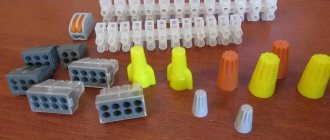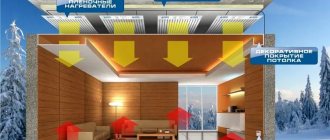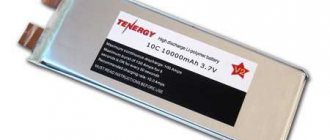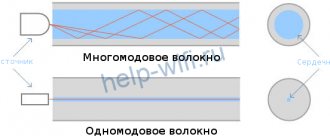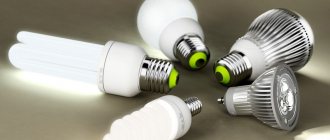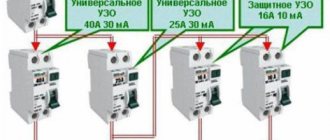Home » Equipment » Warm floor
Most people are increasingly thinking about equipping their home with a variety of heating systems. Some people use superficial methods, such as insulating individual sections of the floor, walls, etc., while others decide to completely renew the floor.
They replace old components with new materials, simultaneously installing water and electrical systems. However, not everyone takes into account that these systems have many positive and negative sides. Warm floors, pros and cons - this will be discussed in this article.
Advantages of heated floors
Convenience and aesthetics:
- the circuit temperature can be easily adjusted, creating a favorable atmosphere and comfort in the room;
- the floor does not overheat and is not excessively cold, the circuit evenly heats all areas of the room;
- the entire structure is hidden under a layer of screed and there are no visible parts on the surface;
- Heat transfer works on the principle of radiation. The accumulated heat is transferred from particle to particle. Convection radiation is minimized as much as possible, and accounts for about 10% of the entire system.
Versatility:
- the system is combined with all kinds of heaters and floor coverings;
- the design can be based on any coolant;
- When choosing floor coverings such as linoleum, parquet, laminate and the like, keep in mind that you need to find out from the manufacturers whether it is possible to combine them with the system that you have chosen. Some finishes are not compatible with electric/water heating systems.
We recommend: How to install a heated film floor?
Environmental friendliness and safety:
- uniform heat flows eliminate the circulation of dust in the room;
- absence of electric magnetic waves due to the fact that the design is based on the contour of the pipes, and not electrical elements.
Efficient Energy Consumption:
- a significant plus is the maximum possible heating of the system to 45-50 degrees. But this is a conditional value; in practice, this parameter does not exceed 30-40 degrees. Because of this undemanding nature, the system is very energy efficient;
- the circuit evenly heats the entire space, but closer to the ceiling the temperature drops by 1-3 degrees. A person does not feel this, and the floor saves up to 20% of electricity. This applies to ordinary rooms with a height of up to 3 meters. However, in enterprises, factories and public places, where the ceiling height is 3 times higher, savings reach 35-45%. Also, taking into account the fact that the heating period lasts on average 200 days, the savings are most noticeable.
But, despite all this, the water heating circuit is quite expensive financially. The complete assembly of the system will cost a pretty penny, even without taking into account the fact that you will involve a specialist.
However, it is worth understanding that you are investing in the long term, since the system, without exaggeration, will serve for decades.
Better maintainability
One of the main advantages of the system is its good maintainability. If the cable fails, it can be replaced without any problems by simply pulling the old one out of the tube and pulling the new one in.
With a heating cable directly embedded in the screed, this trick will not work. In real conditions, the best maintainability of the system is “slightly” different.
Ask any electrician, can he replace a cable laid in a corrugation under the plaster?
The first question he will ask you is “How many turns will there be and at what angle?”
If there are more than three bends, then it will no longer be possible to do this. Now remember the snake that is used to lay heated floors.
How many roundings and turns can you count in an area of at least 10 m2, not to mention much larger sizes?
If you have an exclusive special machine with a pump (it changes the cable in the pipe due to the circulation of liquid under pressure), this can still be done.
But you won’t be able to replace it yourself with a dry one, without special tools. Problems will also arise if there is a hole in the pipe.
This is what a pipe burned through by a burnt cable looks like. The injected liquid will simply flow through it.
In addition, if there is a short circuit on a conventional heating cable, you can find this place of damage, locally open the floor and install a repair coupling there.
A cable immured in a pipe with liquid cannot be repaired locally. You will have to change the whole thing and pay for it in full.
Was the 84-meter-long circuit damaged in any specific place? Please buy these 84 meters again!
Add to this the likelihood of damage to the tube itself, separately from the cable (accidentally drilled or driven in a nail). As a result, additional detachable connections appear in the screed.
Do you think this is normal for further operation of the system?
So it turns out that reliability is noticeably reduced due to all these factors.
Even the vaunted repairability of pipes does not help when they are heated with a hairdryer. As the advertisement says, if any section is broken, just heat it with a hairdryer, and the tube wall will return to its original state.
In fact, in all the pictures, during such repairs, an empty pipe is heated, without coolant. Which means you have another headache.
How to drain and refill antifreeze while maintaining the factory sealing reliability of the entire heating system?
In addition, we can visually check how the tube wall has “restored” only from the outside. No one knows what is happening to her inside.
A decent manufacturer will not give you any guarantee after such a crease.
Cons of a warm water floor
Long heating and cooling
The system cools down quite slowly, unlike its electrical counterparts. Possible solution: installing automation to the pipe circuit will help you quickly adjust the required temperature.
Limited heating area
The further the pipes are stretched from the heat source, the cooler the coolant in them. So, in the farthest rooms the temperature will be much lower. This problem can be solved with the help of additional heating devices or by installing a heating system in the walls.
Network dependency
If there is a sudden power outage, the heating will stop functioning. This has a particularly serious impact on those who own homes in harsh, cold climates.
We recommend: Is it possible to use underfloor heating as the main heating?
Lack of heated air circulation.
If the windows are located higher than 200 cm from the floor, they will periodically fog up, and if they are opened for ventilation, the structure will barely cope with heating the room.
Using air exhaust manifolds will help deal with this situation.
Some disadvantages are so insignificant that they should not be taken into account. In any case, the water heating system has been, remains and will be the most popular in private homes.
What it is?
Traditional methods of heating premises are based on the emission of thermal energy from a specific source. This can be one large heater (such as a furnace) that is enough to maintain the required temperature throughout the entire house. Radiator systems in which hot liquid (coolant) circulates are most often used. Radiators that radiate heat are located in each room and provide convection heating.
Such heating methods are widespread, but ineffective. Circulation of the coolant requires the creation of certain conditions (slope of pipelines, using the rise of heated layers of liquid upward), or the use of circulation pumps. The loss of thermal energy is quite large, and convection does not allow uniform heating of the entire room - there are always warmer and colder areas of the room.
A warm floor is a heating system based on a different principle of thermal energy transfer. Instead of individual point elements, the entire area of the room is used as a source. This approach allows for significant savings on fuel. In addition, losses inherent in traditional heating systems practically disappear. The entire area of the room is heated evenly, eliminating the appearance of cold and warm areas.
The design of a heated floor is one source of thermal energy, evenly distributed under the floor covering over the entire area of the room. Different types of heaters are used, from hot water pipes to electric heating cables or infrared film structures. All types have their own characteristics, limitations and advantages.
Cable heated floor
Cable flooring is most often installed in bathrooms and kitchens, both in private homes and apartments. Cables are divided into:
Single-core
Cables of this type are inexpensive, highly efficient, compared to two-core cables, and do not require electricity.
Twin-core
There is no harmful radiation due to special layers, installation is much easier than with a single-core one.
A common disadvantage of resistive cables is that they cannot be laid under furniture and household appliances, due to possible overheating.
Self-regulating
Pros:
- independently regulate the heating temperature;
- are not susceptible to mechanical damage;
- does not overheat due to automatic regulation;
- long service life;
- simple installation;
- It is allowed to be placed under large furniture.
Minuses:
- high price;
- the system requires a set of ballasts;
- alone cannot warm up the entire room, only the floor.
Cable mats
Advantages of heated floors:
- Ideal for tiles and any type of floor covering;
- simple installation;
- parts of the system are independent of each other (if a section fails, the system will not fail completely).
The disadvantage of mats is their high cost, especially for mats with a two-core cable.
Manufacturers install both single-core and double-core cables. When choosing, keep in mind that a two-wire one will be more efficient.
Comparative assessment of both systems
It is impossible to answer unequivocally which type of heated floor is better.
We can only draw a few general conclusions:
- The cost of arrangement - components and installation of systems is approximately the same. It all depends on the type and operating characteristics of the system. In some cases, an electric floor can benefit from lower component costs.
- The cost of operation for water systems is much lower than for electric ones. Especially when the coolant is heated by a gas boiler.
- Design restrictions . Water systems are not used in the construction of multi-storey buildings.
- Dependence on power supply - electrical systems are dependent on the presence/absence of electricity, water systems will work regardless of this.
- Maintainability . It is cheaper and easier to repair electrical systems. Water-based ones, with the exception of floor options, are difficult and expensive to repair.
In general, both types of underfloor heating have proven themselves well. They warm up rooms evenly and quickly enough, are reliable, and with proper use can last for decades.
When calculating the costs of installing a particular system, you need to remember that before installing a water floor on the first floor of an apartment building, you will need to obtain permission. This means additional costs for collecting documents.
The choice of the type of heating system is also influenced by the type of flooring; more details can be found in the articles:
- Which heated floor to choose for laminate: a comparative analysis of the best options
- Which warm floor is better for tiles: pros and cons of various solutions + review of the best manufacturers
Infrared film floors
The system is based on a carbon layer that covers the film. On the sides the sheets are framed with a copper busbar. It works on the principle of heating a carbon layer with electricity, followed by heat release to the external environment.
We recommend: Operating principle of heated floors
General advantages:
- resistant to sudden temperature changes;
- IR film heats up quickly.
The downside is the rapid cooling of both film and rod sheets.
Infrared film floors
Infrared floors are divided into…
Film:
- the system is quick and easy to install;
- during dismantling, it is possible to reuse the removed structure;
- if a separate part of the system breaks down, the entire circuit will not stop functioning, since the parts are not interconnected and do not depend on each other;
- The film can be easily divided into parts of the required sizes for ease of installation, both in small passages and in large rooms.
Minuses:
- You need to choose your flooring wisely, as it may be too thin or too thick. In the first case, it may be deformed, in the second, the heating efficiency will be reduced;
- The heated floor must be laid on a completely dry surface.
Rod:
- automatic increase and decrease in energy efficiency due to increased or decreased ambient temperature;
- Laying under large pieces of furniture is permitted. Overheating is excluded;
- even if two or more parts fail, the system will function properly.
Disadvantage: mats cannot be combined with a foil backing, since due to the interaction of individual elements, both the film and the backing will be deformed.
Peculiarities
What exactly is an electric water heated floor? Essentially, it is a cross-linked polyethylene pipe with a heating cable inside.
Tube diameter 20mm, thickness 2.5mm. The tube itself is filled with non-freezing liquid. To prevent thermal expansion, an expansion joint is also placed in the pipe.
The entire structure is reliably sealed on both sides and has a given length (7m-14m-21m-28m-35m-42m-56m-70m-84m).
The price of this entire system is significantly more expensive than conventional heated floors. And here a logical question arises: what are we overpaying for and is it worth it?
Recommendations
When choosing a heated floor, take into account the functional features of the system. Also be interested in the possibility of combining heated floors with other building materials.
The advantages of heated floors often come with many disadvantages, so be careful. And no matter what floor you want, purchase products only from trusted manufacturers.
- Related Posts
- How to lay a heated floor in a bathroom under tiles?
- How are PEX pipes connected for heated floors?
- How is xl pipe heated floor installed?
- How are pipes for heated floors installed?
- How to design a heated floor?
- How to install PErt pipes for heated floors?

